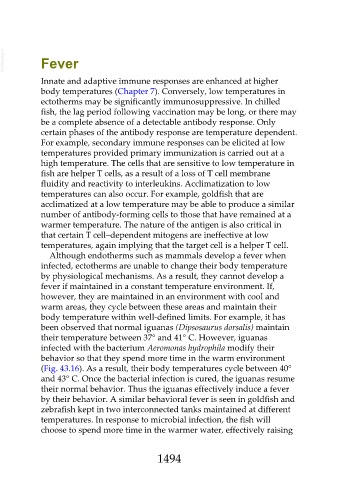Page 1494 - Veterinary Immunology, 10th Edition
P. 1494
VetBooks.ir Fever
Innate and adaptive immune responses are enhanced at higher
body temperatures (Chapter 7). Conversely, low temperatures in
ectotherms may be significantly immunosuppressive. In chilled
fish, the lag period following vaccination may be long, or there may
be a complete absence of a detectable antibody response. Only
certain phases of the antibody response are temperature dependent.
For example, secondary immune responses can be elicited at low
temperatures provided primary immunization is carried out at a
high temperature. The cells that are sensitive to low temperature in
fish are helper T cells, as a result of a loss of T cell membrane
fluidity and reactivity to interleukins. Acclimatization to low
temperatures can also occur. For example, goldfish that are
acclimatized at a low temperature may be able to produce a similar
number of antibody-forming cells to those that have remained at a
warmer temperature. The nature of the antigen is also critical in
that certain T cell–dependent mitogens are ineffective at low
temperatures, again implying that the target cell is a helper T cell.
Although endotherms such as mammals develop a fever when
infected, ectotherms are unable to change their body temperature
by physiological mechanisms. As a result, they cannot develop a
fever if maintained in a constant temperature environment. If,
however, they are maintained in an environment with cool and
warm areas, they cycle between these areas and maintain their
body temperature within well-defined limits. For example, it has
been observed that normal iguanas (Dipsosaurus dorsalis) maintain
their temperature between 37° and 41° C. However, iguanas
infected with the bacterium Aeromonas hydrophila modify their
behavior so that they spend more time in the warm environment
(Fig. 43.16). As a result, their body temperatures cycle between 40°
and 43° C. Once the bacterial infection is cured, the iguanas resume
their normal behavior. Thus the iguanas effectively induce a fever
by their behavior. A similar behavioral fever is seen in goldfish and
zebrafish kept in two interconnected tanks maintained at different
temperatures. In response to microbial infection, the fish will
choose to spend more time in the warmer water, effectively raising
1494

